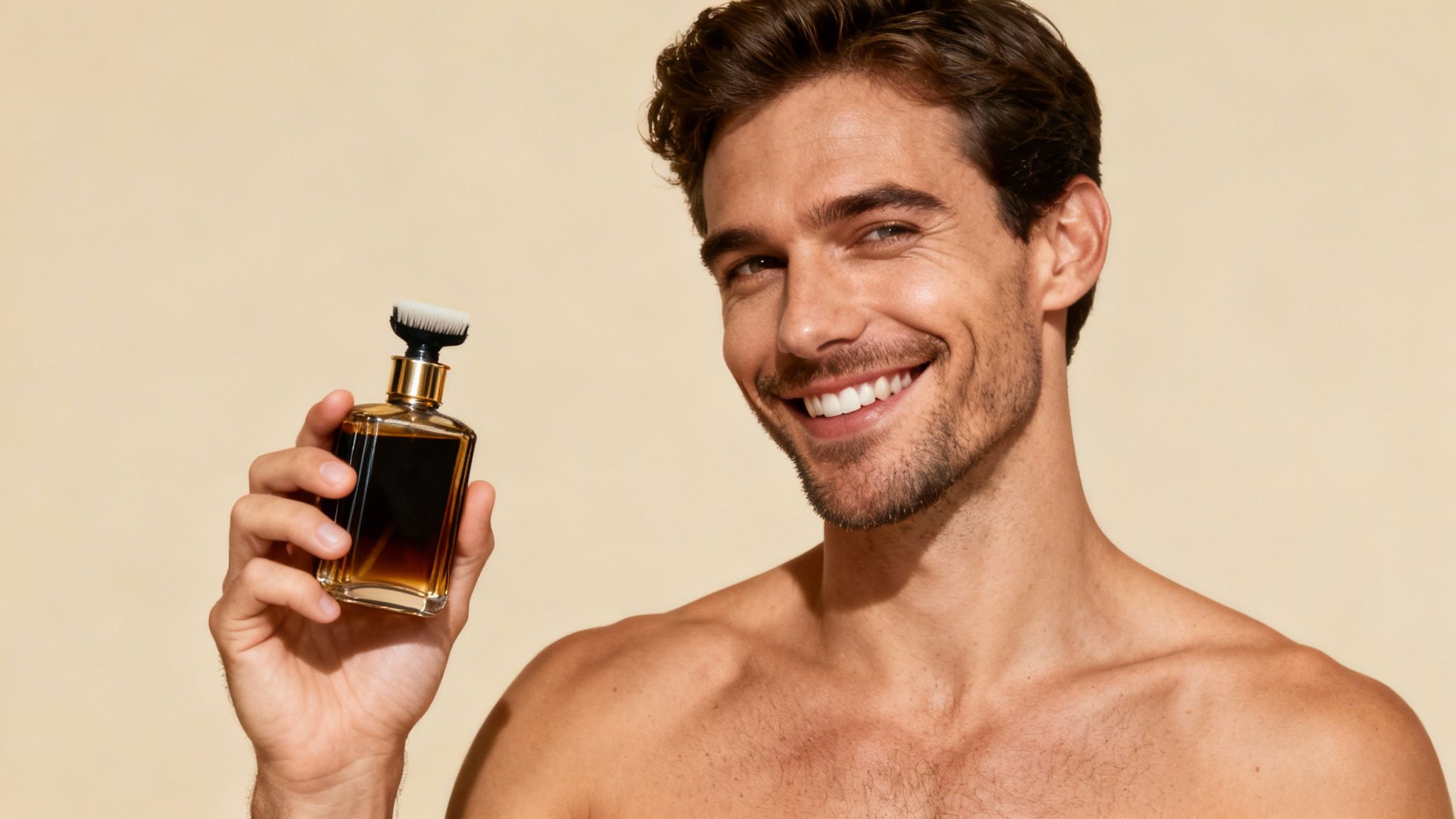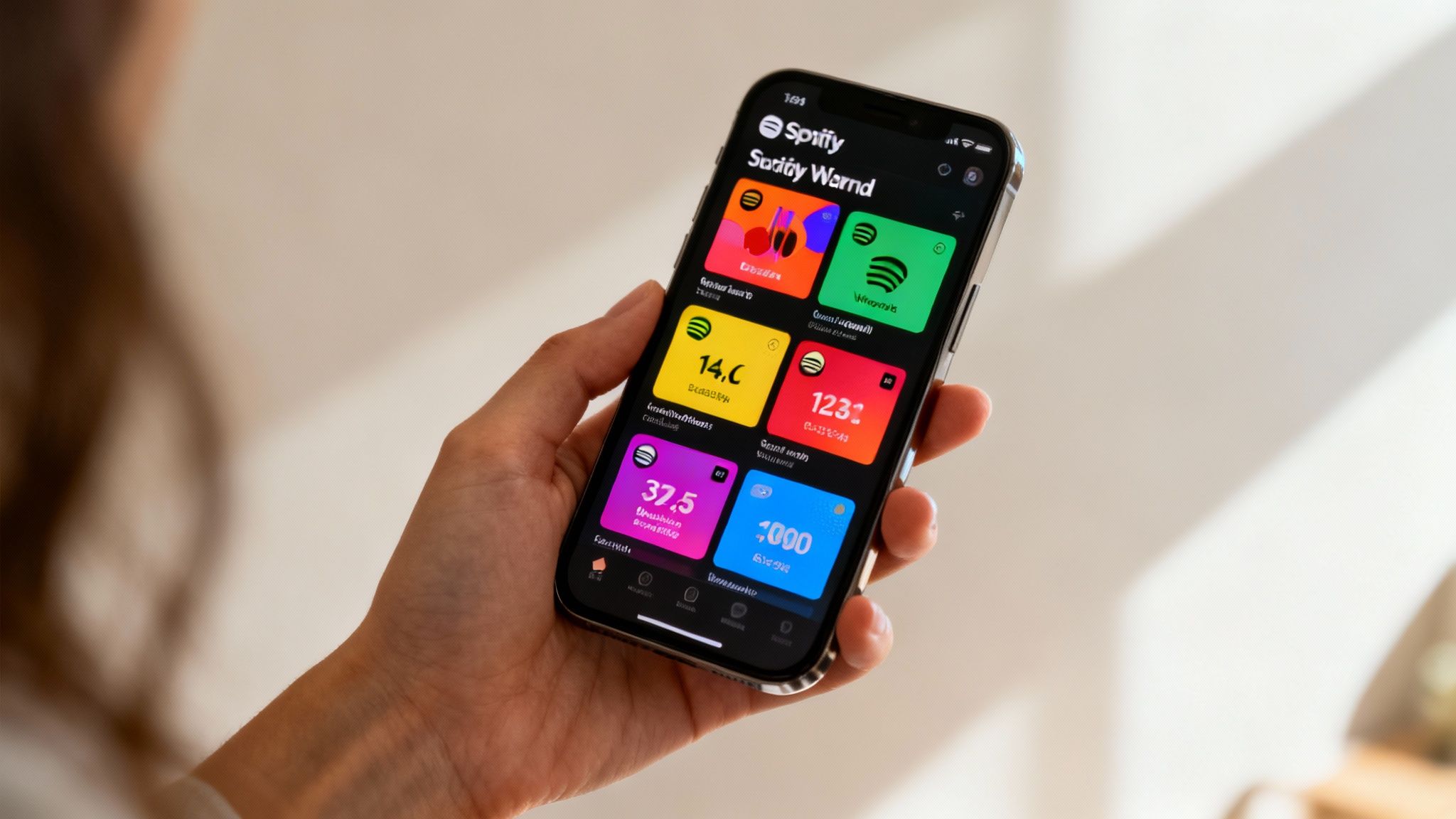In the competitive world of B2B and B2C marketing, a well-executed social media ad campaign can be the difference between obscurity and market leadership. The challenge isn't just creating an ad; it's architecting a campaign that captures attention, drives engagement, and delivers measurable business results. Many marketers look at viral successes and wonder how they can replicate that for their business. The answer lies not in copying tactics, but in understanding the underlying strategy.
This article moves beyond surface-level praise to provide a deep, strategic analysis of some of the best social media ad campaigns to date. We will dissect what made these initiatives successful, from the initial brief and creative execution to the precise channel strategy and key performance indicators (KPIs) that defined their victory. Our focus is on extracting the "how" and the "why" behind each example, transforming iconic campaigns into a playbook for professional services and SaaS marketers.
For each campaign, you will find:
- A Strategic Breakdown: We'll explore the core objectives, target audience, and messaging strategy.
- Creative and Channel Analysis: A look at the visual assets, copy, and platform-specific tactics used.
- Performance and Results: Concrete data and KPIs that demonstrate the campaign's impact.
- Actionable Takeaways: Replicable tactics and strategic frameworks you can adapt and apply to your own marketing efforts, whether you're building brand awareness or driving lead generation.
This is a comprehensive resource designed to equip you with the strategic insights and practical methods needed to develop your own high-performing social media campaigns. Let's analyze the strategies that set the standard for excellence.
1. Dove's 'Real Beauty' Campaign
While it originated before the dominance of social media, Dove's 'Real Beauty' campaign is a foundational example of a brand mission that transitioned seamlessly into one of the best social media ad campaigns ever created. Launched in 2004, the campaign challenged restrictive beauty stereotypes by featuring everyday women instead of professional models. This core message became a long-term platform for creating emotionally resonant content that thrives on social channels.

The campaign evolved from print ads to viral video content and interactive social media initiatives. The "Real Beauty Sketches" video, which garnered over 63 million YouTube views, is a prime example. It powerfully illustrated the gap between how women view themselves and how others see them, sparking a global conversation amplified by hashtags like #RealBeauty.
Strategic Breakdown
Dove’s strategy was rooted in a deep, research-backed consumer insight: only a tiny fraction of women globally considered themselves beautiful. They transformed this insight into a brand purpose, moving beyond product features to a powerful emotional and cultural stance.
Key Strategy: Connect a brand's core value proposition to a larger, universally relatable human truth. Dove didn't just sell soap; it sold self-esteem and championed a more inclusive definition of beauty.
Actionable Takeaways for B2B & Professional Services
Even for B2B or SaaS marketers, the principles behind Dove's success are highly replicable. The key is to shift the focus from what you sell to what you stand for.
- Identify a Core Industry Problem: What is a common frustration or overlooked issue your clients face? It could be complexity in software implementation, a lack of transparency in consulting, or burnout in a specific profession. Build a campaign around solving or highlighting that "human" problem.
- Create Value-Driven Content: Instead of a product demo, create a video series featuring clients discussing how your service simplified their work-life balance. This mirrors Dove's use of real people to build authenticity and trust.
- Foster Community with a Hashtag: Launch a hashtag campaign on LinkedIn that encourages professionals to share their own experiences related to the industry problem you're addressing. This turns passive viewers into active participants, building a community around your brand's mission.
2. Old Spice's 'The Man Your Man Could Smell Like' Campaign
Launched in 2010, Old Spice’s campaign is a masterclass in revitalizing a legacy brand for a new generation. It took a product often associated with grandfathers and, through sheer comedic genius and social media savvy, made it relevant and cool. The campaign’s viral success on platforms like YouTube and Twitter demonstrated how humor and direct audience engagement could create one of the best social media ad campaigns of the digital era.

The initial TV spot featuring a charismatic Isaiah Mustafa in a single, seamless take became an instant YouTube sensation. Old Spice brilliantly capitalized on this momentum with a follow-up interactive video campaign. Mustafa responded to comments and questions from fans and celebrities on social media in near real-time with personalized, short video clips, creating an unprecedented level of brand-to-consumer interaction that solidified its viral status.
Strategic Breakdown
Old Spice’s strategy was to disrupt a stale market with a completely unexpected and absurdist brand persona. They recognized that while men were the end-users, women were often the purchasers of men's body wash. The campaign cleverly spoke to both, creating content that was widely shareable regardless of gender.
Key Strategy: Leverage a distinct and memorable brand persona to create highly shareable, humorous content, then amplify its reach through real-time, direct engagement with the audience on social media platforms.
Actionable Takeaways for B2B & Professional Services
The Old Spice model proves that even "serious" B2B brands can use personality and engagement to cut through the noise. It’s not about being absurd, but about being memorable and interactive.
- Develop a Brand Persona: Instead of generic corporate messaging, define a clear voice. Are you the insightful expert, the helpful mentor, or the innovative challenger? Use this persona consistently across platforms like LinkedIn.
- Create "Rapid Response" Content: Host a live Q&A on LinkedIn with your CEO or a subject matter expert. Instead of pre-scripted answers, address questions from the comments in real-time. This mirrors Old Spice's interactive video responses and builds immense authenticity. Learn more about how to use storytelling in your digital marketing to make your brand persona more compelling.
- Use Humor Strategically: B2B content doesn't have to be dry. Create a series of short, relatable videos or posts about common industry pain points, but with a humorous twist. This humanizes your brand and makes your content far more shareable among professionals.
3. Nike's 'Just Do It' with Colin Kaepernick Campaign
In 2018, for the 30th anniversary of its iconic slogan, Nike launched a campaign that became one of the most polarizing and best social media ad campaigns of the decade. The campaign featured former NFL quarterback Colin Kaepernick, known for his activism against racial injustice, with the powerful tagline: "Believe in something. Even if it means sacrificing everything." This bold move placed Nike at the center of a heated cultural conversation, demonstrating the immense power of purpose-driven marketing in a hyper-connected social landscape.
The campaign unfolded across social media with a simple, impactful image of Kaepernick, a two-minute film titled "Dream Crazy," and the viral hashtag #JustDoIt. Despite initial backlash and calls for boycotts, the campaign was a monumental success. It generated an estimated $43 million in media exposure, and Nike's online sales surged by 31% in the days following its launch, proving that taking a strong stand can build powerful brand loyalty.
Strategic Breakdown
Nike’s strategy was a calculated risk, rooted in a deep understanding of its core audience: young, diverse, and socially conscious consumers. Rather than appealing to everyone, Nike chose to galvanize its most loyal demographic by aligning the brand with values they held dear. The campaign was not just an advertisement; it was a cultural statement.
Key Strategy: Align the brand with a powerful, and even controversial, social cause that resonates deeply with a target audience, trading broad appeal for intense loyalty.
Actionable Takeaways for B2B & Professional Services
While B2B brands may operate in less politically charged arenas, the core principle of value-alignment is a powerful tool for differentiation and building a dedicated client base.
- Define Your Corporate Stance: Identify a core value or industry-specific issue your firm genuinely cares about, such as sustainability in manufacturing, diversity in tech, or mental health in the legal profession. Your stance must be authentic and backed by company action.
- Target Your Core Audience's Values: Use tools like LinkedIn polls or client surveys to understand what professional values and social issues are most important to your ideal clients. Build content that speaks directly to these principles, positioning your firm as a like-minded partner.
- Embrace Bold Storytelling: Instead of case studies focused solely on ROI, create content that tells a human story. Feature a client who used your service to achieve a mission-driven goal, mirroring how Nike focused on Kaepernick's personal sacrifice rather than just athletic achievement.
4. Airbnb's 'Belong Anywhere' Campaign
Airbnb transformed the hospitality industry by shifting the focus from standardized hotel rooms to unique, local experiences. Its 'Belong Anywhere' campaign is a cornerstone of this brand identity, making it one of the best social media ad campaigns by framing travel not as a transaction, but as a path to human connection and cultural immersion. Launched in 2014, the campaign moved Airbnb beyond being a booking platform into a lifestyle brand centered on community and inclusion.
The campaign excels on social media by leveraging authentic, user-generated content and powerful storytelling. Instead of polished advertisements, Airbnb’s social feeds on platforms like Instagram and YouTube feature real host and guest stories, documentary-style videos of unique stays, and initiatives like the “We Accept” Super Bowl ad, which addressed discrimination and reinforced its commitment to inclusivity. This approach turns travel experiences into shareable narratives that resonate on a deep emotional level.
Strategic Breakdown
Airbnb’s strategy was to own the feeling of travel rather than the logistics. They identified a universal human desire to connect with new people and cultures, not just visit new places. By highlighting the stories of its hosts and guests, the company built a brand narrative around community, trust, and the idea that you can feel at home anywhere in the world.
Key Strategy: Position your service as a facilitator of human experiences, not just a transactional tool. Airbnb sells the feeling of belonging, with the platform being the vehicle to achieve it.
Actionable Takeaways for B2B & Professional Services
The 'Belong Anywhere' ethos is powerful for B2B and SaaS brands that want to build a loyal user base. The goal is to make your customers feel like they are part of a community, not just another account number.
- Showcase Customer Success Stories: Move beyond written testimonials. Create short video case studies on LinkedIn that feature clients discussing how your service solved a critical business problem and how your team made them feel supported. Focus on the human relationship, not just the ROI.
- Build a Community-Centric Platform: Use a dedicated Slack channel or a private LinkedIn group for your users. Host exclusive webinars, Q&A sessions with product experts, and encourage members to share best practices. This fosters a sense of belonging and turns customers into brand advocates.
- Align with a Larger Mission: Connect your brand to a relevant industry or social cause. For a cybersecurity firm, this could be a campaign around digital safety for non-profits. This elevates your brand purpose beyond the product, creating a stronger emotional connection with your audience.
5. Wendy's Snarky Twitter Campaign
Wendy's fundamentally changed the rulebook for brand voice on social media, transforming its Twitter presence into one of the most consistently viral and best social media ad campaigns of the modern era. Beginning around 2017, the fast-food chain abandoned the safe, corporate tone of its competitors and adopted a witty, sarcastic, and relentlessly "online" persona. This strategy involved roasting competitors, engaging in hilarious banter with followers, and participating in internet culture in real-time.
The campaign’s genius lies in its authenticity and consistency. By giving its social media team the freedom to be genuinely funny, Wendy's created a personality, not just a marketing channel. Famous examples include their legendary takedowns of McDonald's use of frozen beef and their quick-witted comebacks to users trying to roast them. The result was a massive increase in organic engagement, brand recall, and cultural relevance that paid advertising struggles to achieve.
Strategic Breakdown
Wendy's strategy was to weaponize personality. They recognized that on a platform like Twitter, blending in was a death sentence. By adopting a bold, challenger-brand voice, they could command attention, generate earned media, and build a loyal following that felt like they were part of an inside joke.
Key Strategy: Personify the brand with a distinct, consistent, and platform-native voice that prioritizes authentic engagement over direct selling. Wendy's sold burgers by being the internet's funniest friend, not by running traditional ads.
Actionable Takeaways for B2B & Professional Services
While a snarky tone might not fit a B2B law firm, the underlying principles of personality and real-time engagement are universally applicable, especially on platforms like LinkedIn. For more inspiration, you can explore various social media content ideas to boost engagement.
- Develop a Distinctive Voice: Define a brand persona. Are you the insightful expert, the helpful mentor, or the innovative challenger? Codify this voice and use it consistently across all posts and comments to become recognizable.
- Empower Real-Time Engagement: Don't let comments sit for days. Empower your marketing team to respond quickly and thoughtfully to industry conversations. Joining a relevant LinkedIn discussion with a sharp insight is the B2B equivalent of Wendy's real-time wit.
- Engage, Don't Just Broadcast: Instead of only posting your own content, actively comment on posts from industry leaders, potential clients, and even competitors. Ask insightful questions and offer helpful perspectives to build authority and relationships.
6. Spotify Wrapped Campaign
Spotify's annual 'Wrapped' campaign is a masterclass in turning user data into a viral cultural event, solidifying its place among the best social media ad campaigns. Launched in 2015, the campaign provides each user with a personalized, visually stunning summary of their listening habits from the past year. This includes top artists, songs, and genres, all packaged in a format designed for effortless sharing across social platforms.

The campaign's genius lies in its ability to generate massive organic reach. Each user's 'Wrapped' story is unique, tapping into their sense of identity and prompting them to share. This user-generated content floods platforms like Instagram and Twitter, with hashtags like #SpotifyWrapped trending globally for days and sparking countless memes, comparisons, and conversations.
Strategic Breakdown
Spotify’s strategy weaponizes personalization at scale, transforming routine user data into a highly coveted social asset. The campaign creates a powerful fear of missing out (FOMO), encouraging non-users to join the platform to participate the following year.
Key Strategy: Leverage proprietary data to create hyper-personalized, shareable content that makes each user feel like the star of their own story, turning customers into powerful brand advocates.
Actionable Takeaways for B2B & Professional Services
The core concept of data-driven personalization is incredibly potent for B2B and professional services firms looking to boost engagement. The goal is to provide clients with valuable insights that reflect their own journey with your brand.
- Create Annual Client Reports: Develop a "Year in Review" for your clients. A SaaS company could visualize a user's product usage, key achievements, or ROI. A consulting firm could summarize project milestones and their impact on the client's business.
- Design for Sharability: Package these insights into a visually appealing, easily shareable format like a branded infographic or a short video. Make sure key statistics are bold and clear, and include one-click sharing buttons for platforms like LinkedIn.
- Build Anticipation and Community: Tease the release of these annual reports on your social channels to build excitement. Create a unique hashtag and encourage clients to share their results, fostering a sense of community and friendly competition. This approach can dramatically increase social media engagement.
7. GoPro's User-Generated Content Campaign
GoPro revolutionized marketing by building its entire social media strategy around user-generated content (UGC), effectively turning its customers into its most powerful marketing team. Instead of creating polished, traditional ads, the action camera brand empowered its users to capture and share their most thrilling moments. This masterstroke transformed their social channels into a dynamic showcase of product capabilities, built on authentic, user-created stories.
The strategy is simple yet brilliant: encourage users to submit their best photos and videos for a chance to be featured and win awards. Initiatives like the GoPro Awards program and dedicated hashtags (#GoPro) created a steady stream of high-quality, free content. GoPro then curates the best of this content for its official YouTube, Instagram, and other social media accounts, creating one of the best social media ad campaigns by simply showcasing what its product can do in the hands of real people.
Strategic Breakdown
GoPro’s success lies in building a community-centric ecosystem where the product is the enabler of content, not just the subject. They understood that the most compelling advertisement for their camera was the incredible footage their own customers were already creating. By rewarding and amplifying this content, they created a self-perpetuating marketing engine fueled by user passion and creativity.
Key Strategy: Shift the marketing focus from the brand creating content to the user creating content. Build a platform that empowers, rewards, and amplifies the customer's voice and creativity, turning product usage into a form of brand advocacy.
Actionable Takeaways for B2B & Professional Services
B2B and SaaS brands can adopt the UGC model by reframing it as client-generated content or success stories. The goal is to let your clients become the heroes of your marketing narrative.
- Launch a "Client Spotlight" Initiative: Create a program that encourages clients to share how your software or service has helped them achieve a specific KPI. Feature these stories on your LinkedIn page or in a dedicated blog series.
- Create a Case Study Hashtag: Develop a branded hashtag (e.g.,
#[YourBrand]SuccessStory) and encourage clients to share their wins on platforms like LinkedIn. Reward the best submissions with a discount, a feature, or a free consultation. - Host a Client-Led Webinar: Instead of a sales-led demo, invite a power user to co-host a webinar showcasing their unique workflows and how they leverage your service. This provides authentic social proof and actionable insights for prospects.
8. Glossier's Instagram-First Beauty Campaign
Glossier didn't just adapt to social media; it was born from it. The brand built its entire direct-to-consumer empire on the back of Instagram, proving that a cohesive, community-centric visual strategy can be one of the best social media ad campaigns in its own right. Launched from the popular "Into The Gloss" blog, Glossier bypassed traditional advertising, instead cultivating an aspirational yet relatable aesthetic that felt native to the platform.
The brand's success was fueled by a powerful combination of a meticulously curated feed, authentic influencer partnerships, and a strong emphasis on user-generated content (UGC). By encouraging customers to share their own photos using hashtags like #GlossierIRL, they turned their audience into an army of brand ambassadors. This approach created a flywheel effect where authentic customer content became the brand's most powerful marketing asset.
Strategic Breakdown
Glossier's strategy was to build a brand that looked and felt like a friend's recommendation, not a corporate advertisement. They prioritized community and conversation over direct sales pitches, making their Instagram feed a destination for beauty inspiration rather than just a product catalog. This approach built deep-seated loyalty and organic growth.
Key Strategy: Treat your primary social channel as a product in itself. Build a community-first brand where user-generated content and authentic engagement are the core pillars of the marketing strategy, not just a supplemental tactic.
Actionable Takeaways for B2B & Professional Services
The Glossier model of building a visually cohesive, community-driven brand is highly relevant for professional services and B2B SaaS companies looking to stand out on platforms like LinkedIn.
- Develop a Signature Visual Aesthetic: Don't just post random stock photos. Create a consistent visual identity for your brand on social media using a specific color palette, font style, and type of imagery. This makes your content instantly recognizable in a crowded feed.
- Turn Clients into Advocates: Encourage satisfied clients to share testimonials or case studies on LinkedIn. Feature their stories prominently on your page, creating social proof that is far more powerful than a self-promotional post. You can use platforms like Instagram Reels to share these stories, which can be a powerful way to supercharge your campaign with Reels ads.
- Go Behind the Scenes: Use LinkedIn Stories or short video posts to show the human side of your business. Share clips from team meetings, client workshops, or company culture events. This transparency builds trust and makes your B2B brand more relatable and approachable.
9. Salesforce's Thought Leadership Social Campaign
While not a traditional ad with a direct call-to-action, Salesforce's executive thought leadership strategy is one of the best social media ad campaigns for B2B because it builds invaluable brand equity and trust. The campaign centers on positioning key executives, most notably CEO Marc Benioff, as authoritative voices on business innovation, corporate responsibility, and the future of work. This is executed primarily across professional networks like LinkedIn and Twitter, transforming executive profiles into powerful content distribution channels.
Instead of direct product pitches, the campaign focuses on sharing high-level industry insights, proprietary research, and commentary on current business trends. Posts from executives feel personal and authentic, effectively aligning the company's values with a human face. This approach bypasses the typical corporate noise, creating a direct line of communication with C-suite decision-makers and establishing Salesforce as more than a vendor, but a visionary partner.
Strategic Breakdown
Salesforce’s strategy is built on the principle that in B2B, people buy from people they trust and respect. By elevating its leaders into industry icons, the company builds a protective moat of credibility around its brand. The social content serves as the proof, consistently delivering value to the target audience long before a sales conversation ever begins.
Key Strategy: Transform executives into trusted industry advisors. Use their personal social media platforms to share high-value insights and corporate values, building brand trust and preference from the top down.
Actionable Takeaways for B2B & Professional Services
This human-centric approach is directly applicable to professional services and SaaS, where expertise and trust are the primary currencies. It’s about building a brand through the credibility of its leaders.
- Identify Your Niche Expertise: Pinpoint a specific, high-value area where your firm's leaders possess unique knowledge. This could be AI integration for law firms or sustainable supply chain management for consultants. Make this the central theme of their social content.
- Develop an Executive Content Cadence: Create a simple, sustainable content plan for your leaders. This might include one original LinkedIn article per month, two commentary posts on industry news per week, and daily engagement with relevant conversations. Consistency is more important than volume.
- Share Insights, Not Just Links: Instead of just sharing a company blog post, encourage executives to add a personal, insightful caption. They should explain why the content is important, share a key takeaway, or ask a thought-provoking question to spark genuine discussion and engagement.
10. TikTok's Branded Hashtag Challenges
Instead of creating a single ad, brands on TikTok have pioneered a new form of marketing by architecting viral movements. Branded Hashtag Challenges are among the best social media ad campaigns because they don't just broadcast a message; they invite millions of users to become co-creators. By designing a simple, replicable action set to a catchy sound, brands can spark an explosion of user-generated content (UGC) that carries their message organically across the platform.
A landmark example is e.l.f. Cosmetics' #EyesLipsFace challenge. The brand commissioned an original song that was both catchy and directly referenced its name. This simple audio clip, combined with a basic challenge, inspired over 7 million user videos and garnered billions of views, demonstrating the incredible power of turning an audience into an active marketing force.
Strategic Breakdown
The strategy behind TikTok challenges flips traditional advertising on its head. Instead of a one-to-many broadcast, it creates a many-to-many ripple effect. The focus shifts from high-production creative to crafting a simple, engaging, and highly shareable prompt that the platform's algorithm can then amplify exponentially. It taps into users' desire for creativity, participation, and trend-setting.
Key Strategy: Don't just make an ad; create a platform for user participation. By providing the core elements (a sound, a hashtag, and a simple idea), brands empower users to become their most effective and authentic advertisers.
Actionable Takeaways for B2B & Professional Services
While a dance challenge might not fit a B2B SaaS company, the underlying principles of participation and UGC are incredibly powerful. To learn more about how to adapt these tactics, check out this guide on how to utilize TikTok to market your services or products.
- Create an "Industry Insider" Challenge: Instead of a dance, create a challenge around a common professional experience. For an accounting firm, it could be a
#TaxSeasonConfessionstrend where users share funny or relatable stories using a branded sound. - Leverage Expert Duets: Post a short video of your CEO or an industry expert posing a thought-provoking question or sharing a controversial opinion. Encourage others on LinkedIn or TikTok to use the "Duet" or "Stitch" feature to add their own response, sparking a professional debate.
- Launch a Value-Based Hashtag: Create a hashtag that encourages professionals to share a valuable tip or a productivity hack related to your industry. For example, a project management software could launch
#MyBestWorkflowand feature the most innovative submissions. This builds community and positions your brand as a hub for industry knowledge.
Top 10 Social Media Ad Campaigns Comparison
Final Thoughts
As we've journeyed through this curated gallery of the best social media ad campaigns, a clear and powerful narrative emerges. From Dove's profound emotional connection to Wendy's razor-sharp wit, and Salesforce's B2B thought leadership, the common thread is not a singular tactic or channel. Instead, it's a deep, strategic understanding of human behavior, community dynamics, and brand identity.
The campaigns that truly resonate and drive results are those that move beyond simple promotion. They don't just sell a product; they invite participation, spark conversation, and build a sense of belonging. They prove that in the crowded digital landscape, authenticity isn't just a buzzword; it's the ultimate competitive advantage.
Synthesizing the Core Principles of Winning Campaigns
Distilling the success of giants like Nike, Spotify, and Airbnb, we can identify several foundational pillars that B2B and professional services marketers can build upon. These aren't just creative flourishes; they are strategic imperatives for anyone looking to make a genuine impact.
Three Unifying Themes:
- Audience-Centricity Over Brand-Centricity: The most effective campaigns put the audience at the heart of the story. GoPro celebrated its users' adventures, not just its cameras. Spotify Wrapped is a personal retrospective for the listener, not a lecture on streaming technology. Your brand is the enabler, not the hero of the story.
- Platform-Native Creativity: A winning strategy on Instagram, with its visual-first ethos like Glossier's, won't work on Twitter, where Wendy's thrives on concise, conversational jabs. The campaigns we analyzed didn't just syndicate content; they spoke the native language of each platform, respecting its culture and user expectations.
- Emotion and Value as Currency: Whether it's the inspiration from Nike's Kaepernick ad or the pure entertainment of an Old Spice commercial, emotion drives engagement. For B2B brands like Salesforce, the currency is intellectual value, providing insights that empower their audience. The goal is to make your audience feel or learn something memorable.
Actionable Next Steps for Your Brand
Moving from inspiration to implementation is the critical next step. The lessons from these best social media ad campaigns are not just for consumer brands with massive budgets. The principles are scalable and adaptable for professional services, SaaS, and B2B firms.
Here is a simple framework to get started:
- Conduct a Channel Audit: Re-evaluate your current social media channels. Are you treating them as distinct communities, or as a content dumping ground? Align your strategy with the unique culture of each platform.
- Define Your "Why": Beyond your product features, what value do you provide? Is it education, community, entertainment, or inspiration? This "why" should be the central theme of your campaign creative.
- Pilot a UGC or Interactive Campaign: Start small. Encourage clients to share their success stories using your service with a specific hashtag. Run a poll or an "Ask Me Anything" session on LinkedIn with one of your subject matter experts. This builds community and generates authentic content simultaneously.
- Measure What Matters: Shift your focus from vanity metrics like simple follower counts to engagement rates, share of voice, and, ultimately, lead quality. The goal is to build relationships that convert, not just to broadcast a message.
Ultimately, mastering social media advertising in today's market is about building a brand that people want to connect with. It's about being human, being valuable, and being memorable. By applying these strategic takeaways, you can begin crafting campaigns that not only capture attention but also build lasting client relationships and drive sustainable growth for your firm.
Ready to transform these insights into a high-performance advertising strategy for your own business? The team at Twelverays specializes in crafting and executing data-driven social media ad campaigns that drive measurable results for B2B and professional services firms. Visit Twelverays to see how we can help you build your next iconic campaign.





